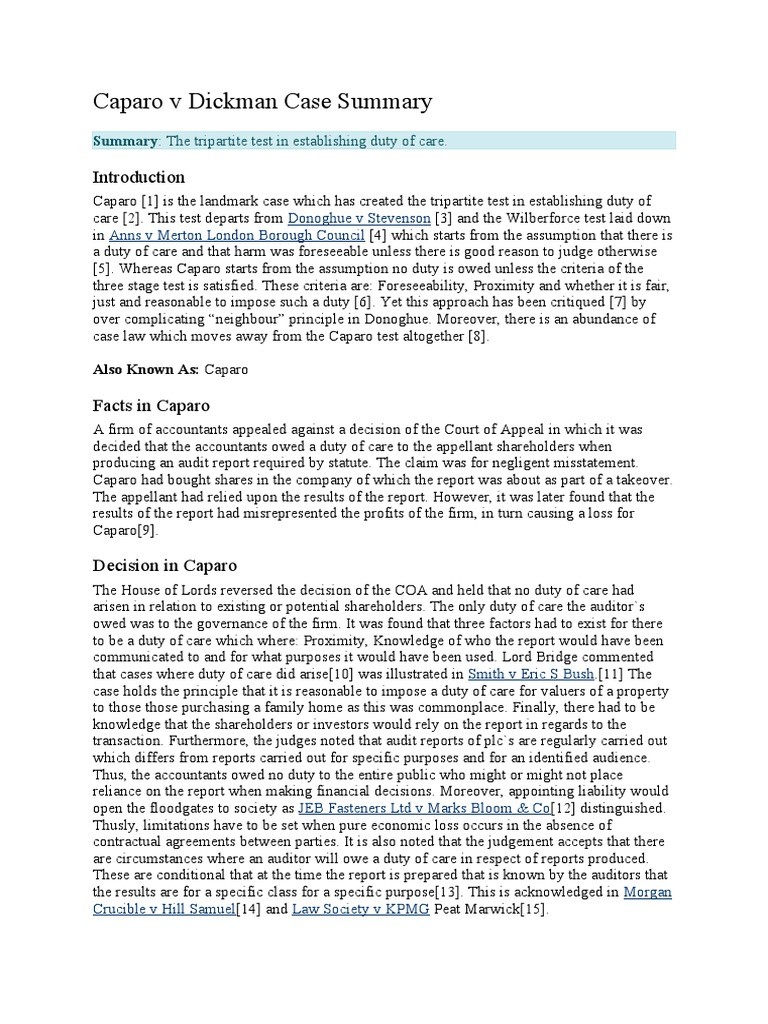Caparo v Dickman Case Summary: Implications for Automotive Supply Chain Liability
The case revolves around the negligence and liability of a car manufacturer, Dickman, towards a third-party, Caparo, who suffered financial losses due to a faulty car part manufactured by Dickman. Caparo subsequently brought a claim against Dickman Ltd., the manufacturer of a faulty car part, which allegedly caused the financial losses sustained by Caparo. The Caparo v Dickman case is a significant decision in the world of car manufacturing, setting important precedents for product liability and third-party liability
Case Summary: Caparo v Dickman - A Landmark Decision in the World of Car Manufacturing
The Caparo v Dickman case, heard by the House of Lords in 1990, is a landmark decision in the field of car manufacturing, setting a crucial precedent for product liability in the industry. The case revolves around the negligence and liability of a car manufacturer, Dickman, towards a third-party, Caparo, who suffered financial losses due to a faulty car part manufactured by Dickman. This article provides a comprehensive summary of the case, highlighting its significance in the world of car manufacturing and the implications it has on the industry as a whole.
Background
In the early 1980s, Caparo Electric Motors Ltd., a UK-based company, acquired a majority stake in an English car manufacturer, Tewkesbury Motor Company Ltd. In 1983, Tewkesbury Motor Company Ltd. ceased trading, leaving Caparo Electric Motors Ltd. with a significant financial loss. Caparo subsequently brought a claim against Dickman Ltd., the manufacturer of a faulty car part, which allegedly caused the financial losses sustained by Caparo.
The Faulty Car Part
The faulty car part in question was a cylinder head manufactured by Dickman Ltd. and installed in a diesel engine supplied by Tewkesbury Motor Company Ltd. to Caparo. The cylinder head was designed to operate at high temperatures, but it did not meet the required specifications. As a result, the engine's performance was severely impacted, causing significant financial losses to Caparo.
The Claim
Caparo claimed that Dickman Ltd. was negligent in the design and manufacture of the cylinder head, which led to the faulty engine performance and subsequent financial losses. Caparo argued that Dickman Ltd. owed a duty of care to Caparo as a third-party, as a result of the car part being installed in the diesel engine.
The Decision
The House of Lords, in its landmark decision, held that Dickman Ltd. did not owe a duty of care to Caparo as a third-party. The Lords emphasized that there must be a "necessary link" between the parties for a duty of care to arise. In this case, the link between Dickman Ltd. and Caparo was too remote, as Caparo was not in a direct relationship with Dickman Ltd. at the time of the faulty car part's installation.
Key Takeaways
The Caparo v Dickman case has significant implications for the car manufacturing industry:
- Third-Party Liability: The case establishes that a car manufacturer may not be liable for third-party losses resulting from a faulty car part, unless there is a direct relationship between the parties.
- Duty of Care: The decision highlights the need for a "necessary link" between the parties for a duty of care to arise. In the absence of such a link, a car manufacturer may not be held liable for third-party losses.
- Risk Assessment: The case emphasizes the importance of risk assessment in the design and manufacture of car parts. Car manufacturers must carefully assess the potential risks associated with their products to minimize the likelihood of faulty car parts being installed.
Conclusion
The Caparo v Dickman case is a significant decision in the world of car manufacturing, setting important precedents for product liability and third-party liability. The case highlights the need for car manufacturers to carefully assess the risks associated with their products and to ensure that their designs and manufacturing processes meet the required specifications. By understanding the key takeaways from this case, car manufacturers can better mitigate the risk of faulty car parts and minimize the potential for financial losses.
Additional Relevant Keywords:
- Product liability
- Third-party liability
- Car manufacturing
- Faulty car parts
- Risk assessment
- Duty of care



 Naomi Johnson
Naomi Johnson




















